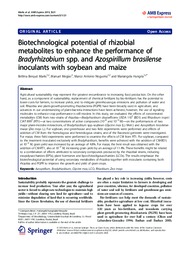Biotechnological potential of rhizobial metabolites to enhance the performance of Bradyrhizobium spp. and Azospirillum brasiliense inoculants with soybean and maize.
Biotechnological potential of rhizobial metabolites to enhance the performance of Bradyrhizobium spp. and Azospirillum brasiliense inoculants with soybean and maize.
Author(s): MARKS, B. B.; MEGÍAS, M.; NOGUEIRA, M. A.; HUNGRIA, M.
Summary: Agricultural sustainability may represent the greatest encumbrance to increasing food production. On the other hand, as a component of sustainability, replacement of chemical fertilizers by bio-fertilizers has the potential to lower costs for farmers, to increase yields, and to mitigate greenhouse-gas emissions and pollution of water and soil. Rhizobia and plant-growth-promoting rhizobacteria (PGPR) have been broadly used in agriculture, and advances in our understanding of plant-bacteria interactions have been achieved; however, the use of signaling molecules to enhance crop performance is still modest. In this study, we evaluated the effects of concentrated metabolites (CM) from two strains of rhizobia-Bradyrhizobium diazoefficiens USDA 110T (BD1) and Rhizobium tropici CIAT 899T (RT1)?at two concentrations of active compounds (10-8 and 10-9 M)_on the performances of two major plant-microbe interactions, of Bradyrhizobium spp.-soybean (Glycine max (L.) Merr.) and Azospirillum brasilense-maize (Zea mays L.). For soybean, one greenhouse and two field experiments were performed and effects of addition of CM from the homologous and heterologous strains, and of the flavonoid genistein were investigated. For maize, three field experiments were performed to examine the effects of CM from RT1. For soybean, compared to the treatment inoculated exclusively with Bradyrhizobium, benefits were achieved with the addition of CM-BD1; at 10?9 M, grain yield was increased by an average of 4.8%. For maize, the best result was obtained with the addition of CM-RT1, also at 10?9 M, increasing grain yield by an average of 11.4%. These benefits might be related to a combination of effects attributed to secondary compounds produced by the rhizobial strains, including exopolysaccharides (EPSs), plant hormones and lipo-chitooligosaccharides (LCOs). The results emphasize the biotechnological potential of using secondary metabolites of rhizobia together with inoculants containing both rhizobia and PGPR to improve the growth and yield of grain crops.
Publication year: 2013
Types of publication: Journal article
Unit: Embrapa Soybean
Keywords: Soja
Related content
Observation
Some of Embrapa's publications are published as ePub files. To read them, use or download one of the following free software options to your computer or mobile device. Android: Google Play Books; IOS: iBooks; Windows and Linux: Calibre.
Access other publications
Access the Agricultural Research Database (BDPA) to consult Embrapa's full library collection and records.
Visit Embrapa Bookstore to purchase books and other publications sold by Embrapa.

